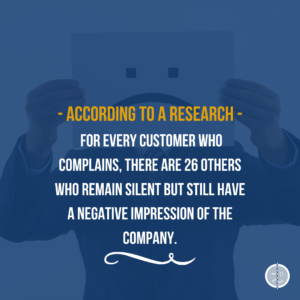In today’s highly competitive market, handling customer complaints is critical for every business that wants to prosper. As businesses, we all endeavor to deliver our customers’ best possible experience, but mistakes will always occur. This is when customer complaints come into play. They are an unavoidable aspect of running any business, and while they may be unpleasant to deal with, treating them appropriately can make or break customer satisfaction and loyalty. In this blog article, we’ll look at why it’s vital to address customer complaints, why customers complain in the first place, and how we may properly handle those concerns.
Why Handling Customer Complaints is Important
The first reason that dealing with customer complaints is crucial is that it gives us valuable feedback. Customers that take the time to express their issues or critiques provide us with an opportunity to enhance our products or services. We can improve our business and make it more customer-centric by listening to and acting on their comments.

Furthermore, resolving customer concerns might assist in avoiding poor word-of-mouth and reviews, which can immensely harm a business’s reputation. According to studies, angry customers are more likely to tell their friends and family about a bad experience than pleased customers are to share a good one. We can turn unpleasant experiences into positive ones by responding to complaints swiftly and effectively, which can help to increase customer loyalty and advocacy.
Why Customers Complain
Before we get into how to address customer complaints, we need to understand why they complain in the first place. There are numerous reasons why a customer may feel the need to express their concerns. However, the following are some of the most common:
- Poor product quality or service delivery: If a product or service doesn’t meet customers’ expectations, they may feel compelled to complain.
- Unmet expectations: Customers may have unrealistic expectations that the product or service does not meet.
- Bad customer service: If a client believes they have been treated unfairly or improperly by a firm, they may file a complaint to seek restitution.
- Billing and price issues: Billing mistakes or ambiguous pricing schemes can cause annoyance and complaints.
- Communication breakdowns: When customers believe they are not being heard or understood by a company, they may complain.
5 Surefire Ways to Turn Angry Customers into Loyal Fans
Every business has had to deal with irate customers at some point in its history. It can be difficult and overwhelming, especially when there seems to be nothing you can do to make them happy. But, keep in mind that how you manage these circumstances can mean the difference between an upset customer and a loyal fan.
Here are five certain strategies to convert those angry customers into lifelong supporters of your business:
1. Listen and Empathize
The first step in resolving any customer service issue is to listen to the customer and empathize with their concerns actively. Allow them to express their frustration and really hear what they are saying. Often, just knowing that someone is listening can go a long way in calming them down.
Once you have heard their concerns, acknowledge their feelings and empathize with their situation. Let them know that you understand their frustration and that you are committed to finding a solution that will make them happy.
2. Take Responsibility and Apologize
After listening to and comprehending the customer’s complaints, it’s critical to take ownership of the situation and apologise for any inconvenience or annoyance they may have felt. Accepting responsibility demonstrates to the customer that you appreciate their company and are dedicated to making things right.
Apologizing can also help to defuse a conflict and make the customer feel heard and validated. In your apologies, be real and explicit, identifying the exact issue and expressing regret for any poor experience they may have had.
3. Offer a Solution
It’s time to propose a remedy once you’ve listened to the customer and apologized for the problem. This can range from a refund or exchange to a discount or extra service. The idea is to create a solution that fits the customer’s needs and demonstrates your commitment to making things right.
Communicate in a straightforward and clear manner, detailing the steps you will take to remedy the issue and any timetables or expectations the customer should have. Keep your commitments and ensure that the customer is delighted with the outcome.
4. Go the Extra Mile
A simple remedy may not always be sufficient to convert an angry customer into a devoted follower. In these situations, it’s critical to go above and above to demonstrate your dedication to their pleasure.
This could involve providing additional money or incentives, personally reaching out to them to enquire about their experience, or even providing a customised solution that goes above and beyond what was initially offered.
Going above and beyond can not only convert an angry customer into a loyal fan, but it can also lead to positive word-of-mouth and referrals, boosting your business reputation.
5. Follow Up and Follow Through
Finally, after the matter has been fixed, it is critical to follow up with the customer to ensure they are still satisfied with the outcome. This demonstrates that you are concerned about their experience and are dedicated to their continuous fulfilment.
Along with following up, keeping any pledges or commitments made during the resolution process is critical. This could include honouring discounts or service agreements and merely checking in to ensure that the customer’s needs are addressed.
By following these five surefire ways to turn angry customers into loyal fans, you can resolve customer service issues and improve your business’s reputation and customer loyalty. Keep in mind that one of the important things that businesses need to handle client complaints effectively is a toolkit. The proper templates for responding to customer complaints, rules for managing different sorts of complaints, and methods for tracking and evaluating customer feedback should all be included in the toolkit.
Examples of Handling Customer Complaints
Zappos:
Zappos is known for its great customer service, and how they handle complaints is a key part of that. In one case, a customer complained about a scuffed pair of shoes that had been delivered. Zappos not only replaced the shoes but also sent the client a bouquet of flowers to apologize for the inconvenience.
Southwest Airlines:
A Southwest Airlines passenger tweeted in 2017 about a gate worker who went above and above to assist her and her family during a stressful flight. As the tweet went viral, Southwest Airlines replied by giving the gate worker a gift card and a note of thanks.
Apple:
When Apple released its Maps app in 2012, it was widely panned for its inaccuracy and problems. CEO Tim Cook apologised publicly and vowed to update the app. Apple rapidly addressed the shortcomings, and the Maps app is currently regarded as one of the best on the market.
When to Handle Customer Complaints
Finally, knowing when to handle customer complaints is critical. Preferably, you should handle complaints as soon as they arise, but this is not always practicable. Here are some examples of when it is critical to resolve complaints:
- When a customer directly reaches you: If a customer contacts you by phone, email, or social media with a complaint, it is critical that you answer swiftly and address their concerns.
- When a poor review is placed online: Whenever a customer posts a negative review on your website or social media pages, it’s critical to respond publicly and offer a remedy.
- When a customer complains with a third party: If a customer lodges a complaint with a third party, such as a regulatory body or the Better Business Bureau, it is critical to reply and collaborate with the third party to fix the issue.
Conclusion
Customer complaints are unavoidable in running a business, but how they are handled may make or break customer happiness and loyalty. We may turn negative encounters into positive ones and develop trust and loyalty with our customers by responding fast, listening carefully, apologising honestly, taking action, and following up. Remember that complaints are an opportunity to develop and grow as a business, so embrace and capitalise on them.
The fact is that customers have many options nowadays; if they do not believe their complaints are being addressed, they will simply take their business somewhere. Businesses require the correct toolkit, strategy, and training to address customer complaints efficiently. Templates for responding to client complaints, rules for managing different sorts of complaints, and methods for tracking and evaluating customer feedback should all be included in the toolkit. The process should be well-defined and simple to follow, with each team member allocated specific tasks and duties. Finally, all personnel should be trained on how to address consumer concerns with sensitivity and professionalism.


